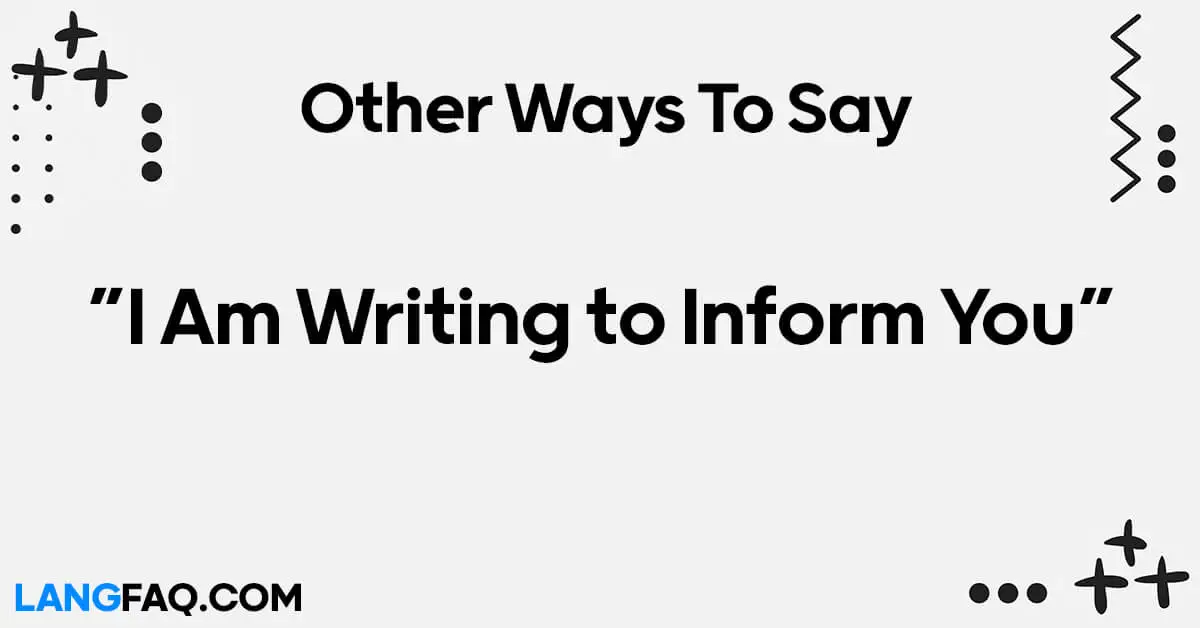In the realm of written communication, finding alternative phrases for common expressions can add depth and professionalism to your message. One such phrase often used is “I am writing to inform you.” While it serves its purpose, diversifying your language arsenal can enhance your communication skills. In this article, we’ll explore 12 alternative ways to express the same sentiment, offering versatility and sophistication to your written correspondence.
12 Other Ways to Say “I Am Writing to Inform You”
Here are 12 alternative ways to say “I am writing to inform you”:
- I want to bring to your attention
- I wish to notify you
- I’m reaching out to share
- I’m advising you that
- I’d like to alert you to
- I’m informing you about
- I thought I should make you aware
- I’d like to apprise you of
- I’m bringing to your notice
- I’m updating you on
- I’m presenting you with
- I’m conveying to you
| Expression | Meaning | Example |
|---|---|---|
| I want to bring to your attention | Drawing focus to a specific matter | “I want to bring to your attention the upcoming deadline.” |
| I wish to notify you | Formal notification | “I wish to notify you of the changes to our meeting schedule.” |
| I’m reaching out to share | Sharing important information | “I’m reaching out to share the latest updates on our project.” |
| I’m advising you that | Offering guidance or counsel | “I’m advising you that the deadline has been extended.” |
| I’d like to alert you to | Urgently informing about something | “I’d like to alert you to the safety precautions for the event.” |
| I’m informing you about | Providing information | “I’m informing you about the new company policies.” |
| I thought I should make you aware | Ensuring awareness of a situation | “I thought I should make you aware of the potential risks.” |
| I’d like to apprise you of | Informing or updating about something | “I’d like to apprise you of the current market trends.” |
| I’m bringing to your notice | Highlighting a particular detail | “I’m bringing to your notice the errors in the report.” |
| I’m updating you on | Providing the latest information | “I’m updating you on the progress of our project.” |
| I’m presenting you with | Offering information or options | “I’m presenting you with the opportunity to join our team.” |
| I’m conveying to you | Passing on information or messages | “I’m conveying to you our gratitude for your support.” |
These alternative expressions offer a variety of ways to convey the message “I am writing to inform you” with clarity and professionalism. By choosing the appropriate expression based on context and tone, communicators can enhance the effectiveness of their written correspondence.
Is It Correct to Say “I Am Writing to Inform You”?
Yes, “I am writing to inform you” is a grammatically correct and commonly used phrase in written communication. It is a formal and direct way to convey the purpose of the message, indicating that the sender is communicating specific information to the recipient through written correspondence.
This phrase is often used in professional or business settings when sending emails, letters, memos, or other written documents to inform someone about important updates, announcements, changes, or developments. It sets the tone for the rest of the message, signaling to the recipient that they should pay attention to the information being provided.
While “I am writing to inform you” is grammatically correct and widely accepted, there are also several alternative phrases that can be used to convey the same message with slightly different nuances or tones. These alternatives include expressions such as “I want to bring to your attention,” “I wish to notify you,” “I’m reaching out to share,” and others, which offer variations in tone, formality, and emphasis while still effectively communicating the purpose of the message.
Ultimately, the choice of phrase depends on the context, audience, and desired tone of the communication. Whether using “I am writing to inform you” or one of its alternatives, the goal is to clearly and effectively communicate the intended message to the recipient.
Professional Mail Example With “I Am Writing to Inform You”
Subject: Important Update Regarding Project Deadline Extension
Dear [Recipient’s Name],
I hope this email finds you well.
I am writing to inform you about an important update regarding the project deadline. Due to unforeseen circumstances and challenges encountered during the implementation phase, we have decided to extend the deadline for project completion.
The new deadline for project submission is [new deadline date]. This extension will allow our team to address any issues effectively and ensure the delivery of a high-quality outcome that meets our standards and client expectations.
We understand the importance of adhering to project timelines and apologize for any inconvenience this may cause. Rest assured, we are committed to minimizing any impact on project deliverables and will work diligently to mitigate any potential risks.
Please review the updated project timeline attached to this email for more details. If you have any questions or concerns regarding this extension, please don’t hesitate to reach out to me directly.
Thank you for your attention to this matter and your continued dedication to the success of our projects.
Best regards, [Your Name] [Your Position/Title] [Your Contact Information]
I want to bring to your attention
Bringing attention to specific matters is crucial in both formal and informal communication. This phrase serves as a polite yet assertive way to highlight important information that requires immediate consideration.
Explanation: “I want to bring to your attention” is used to direct the recipient’s focus towards a particular issue, update, or concern. It signifies urgency and importance while maintaining professionalism.
Scenario: In a formal business setting, this phrase can be used to address discrepancies in a project report:
Example Sentence: “I want to bring to your attention the errors identified in the financial statements.”
Email Sample:
Subject: Attention Needed: Financial Report Errors
Dear [Recipient’s Name],
I hope this email finds you well. I wanted to bring to your attention some discrepancies that have been identified in the financial statements for the quarter. It’s crucial that we address these issues promptly to ensure accuracy in our records.
Thank you for your attention to this matter.
Best regards, [Your Name]
Variations:
- Colleague to colleague: “Hey, I want to bring something to your attention regarding the upcoming meeting agenda.”
- Mentor to mentee: “As your mentor, I want to bring to your attention the importance of time management in your project planning.”
Pros:
- Conveys urgency and importance effectively.
- Maintains a professional tone.
- Directs focus towards specific issues or concerns.
Cons:
- May come across as too assertive in casual communication settings.
- Should be used judiciously to avoid overuse and desensitization.
Related Insights: According to Cambridge Dictionary, bringing something to someone’s attention means making them notice or become aware of something. It implies that the recipient needs to pay attention to the information provided.
Usage Tip: Use this phrase sparingly and reserve it for situations where immediate attention is required to address important matters.
I wish to notify you
Formal notifications often require a clear and concise introduction. “I wish to notify you” is a polite and straightforward way to inform the recipient of important updates, changes, or announcements.
Explanation: “I wish to notify you” indicates the sender’s intention to formally communicate information to the recipient. It sets a tone of professionalism and clarity in the message.
Scenario: In a corporate setting, this phrase can be used to announce changes to company policies:
Example Sentence: “I wish to notify you of the updates to our remote work policy effective immediately.”
Email Sample:
Subject: Notification: Remote Work Policy Updates
Dear [Recipient’s Name],
I wish to notify you of the recent updates to our company’s remote work policy. These changes will be effective immediately and are outlined in detail in the attached document.
Thank you for your attention to this matter.
Sincerely, [Your Name]
Variations:
- Formal announcement: “I wish to notify you of the upcoming changes to our team structure.”
- Informal notification: “Hey, just wanted to notify you about the new menu items at our favorite restaurant.”
Pros:
- Clearly indicates the purpose of the communication.
- Maintains a respectful and professional tone.
- Provides recipients with important information in a direct manner.
Cons:
- May sound overly formal in casual or personal communication.
- Should be followed by clear and concise details to avoid ambiguity.
Related Insights: According to Merriam-Webster, to notify means to give formal notice of something to someone.
Usage Tip: Use this phrase when announcing official updates, changes, or announcements in both formal and professional settings.
I’m reaching out to share
When initiating communication to impart important information or updates, it’s essential to establish a friendly and collaborative tone. “I’m reaching out to share” conveys openness and willingness to engage in dialogue while delivering the message effectively.
Explanation: “I’m reaching out to share” signifies the sender’s proactive approach to communication, emphasizing collaboration and mutual sharing of information.
Scenario: In a collaborative project, this phrase can be used to share progress updates with team members:
Example Sentence: “I’m reaching out to share the latest progress on our project timeline.”
Email Sample:
Subject: Project Update: Milestone Achieved
Hi [Recipient’s Name],
I hope this email finds you well. I’m reaching out to share some exciting news—we’ve successfully reached a significant milestone in our project timeline. Please find attached the detailed progress report for your review.
Looking forward to discussing further during our next team meeting.
Best regards, [Your Name]
Variations:
- Informal communication: “Hey, just wanted to reach out and share some good news with you.”
- Collaborative effort: “We’re reaching out to share the latest updates on the community event planning.”
Pros:
- Establishes a friendly and approachable tone.
- Encourages open communication and collaboration.
- Sets a positive tone for sharing information or updates.
Cons:
- May sound too casual for formal or professional communication in certain contexts.
- Should be used appropriately based on the relationship with the recipient and the nature of the message.
Related Insights: According to Oxford Languages, reaching out means making contact or attempting to communicate with someone, typically to offer or request assistance or information.
Usage Tip: Use this phrase to initiate communication in a friendly and collaborative manner, particularly when sharing updates, information, or news with colleagues, clients, or stakeholders.
I’m advising you that
Offering guidance or counsel is a delicate yet essential aspect of effective communication. “I’m advising you that” communicates authority and expertise while providing valuable insights or recommendations to the recipient.
Explanation: “I’m advising you that” indicates the sender’s role as an advisor or mentor, offering valuable guidance or counsel to the recipient.
Scenario: In a mentorship relationship, this phrase can be used to provide constructive feedback to a mentee:
Example Sentence: “I’m advising you that incorporating more visual elements in your presentation can enhance its impact.”
Email Sample:
Subject: Advice on Presentation Enhancement
Dear [Recipient’s Name],
I hope you’re doing well. I’m advising you that incorporating more visual elements in your presentation can significantly enhance its impact and engage the audience effectively. I’ve attached some resources and examples for your reference.
Please feel free to reach out if you have any questions or need further assistance.
Best regards, [Your Name]
Variations:
- Colleague to colleague: “Hey, I’m advising you that proofreading your emails before sending them can help avoid misunderstandings.”
- Supervisor to employee: “As your supervisor, I’m advising you that prioritizing tasks based on deadlines is essential for meeting project goals.”
Pros:
- Demonstrates expertise and authority in the subject matter.
- Provides valuable insights or recommendations to the recipient.
- Fosters a supportive and collaborative environment for growth and development.
Cons:
- May come across as directive or patronizing if not delivered with empathy and respect.
- Should be used judiciously to avoid overwhelming the recipient with unsolicited advice.
Related Insights: According to Dictionary.com, to advise means to offer suggestions about the best course of action to someone.
Usage Tip: Use this phrase when providing guidance, recommendations, or constructive feedback to colleagues, mentees, or individuals seeking advice in professional or personal contexts.
I’d like to alert you to
Urgently informing someone about a specific matter or situation requires a direct and assertive approach. “I’d like to alert you to” conveys a sense of urgency while ensuring the recipient is aware of the important information being shared.
Explanation: “I’d like to alert you to” serves as a formal yet decisive way to inform the recipient about a matter that requires immediate attention or action.
Scenario: In a business context, this phrase can be used to notify stakeholders about potential risks or security breaches:
Example Sentence: “I’d like to alert you to the recent data breach detected in our system.”
Email Sample:
Subject: Urgent Alert: Data Breach Detected
Dear [Recipient’s Name],
I’d like to alert you to the recent data breach detected in our system. It’s crucial that we take immediate action to investigate the breach and implement necessary security measures to mitigate any potential risks.
Please refer to the attached document for detailed information and instructions on next steps.
Thank you for your attention to this urgent matter.
Best regards, [Your Name]
Variations:
- Emergency notification: “I’d like to alert you to the severe weather warning issued for our area.”
- Security alert: “I’m alerting you to the suspicious activity detected on your account.”
Pros:
- Conveys urgency and importance effectively.
- Ensures the recipient is promptly informed about critical matters.
- Provides an opportunity for proactive action or response to potential risks or issues.
Cons:
- May induce panic or anxiety if not accompanied by clear instructions or solutions.
- Should be reserved for genuine emergencies or significant concerns to avoid desensitization.
Related Insights: According to Merriam-Webster, to alert means to give notice to someone of something that requires attention or action.
Usage Tip: Use this phrase cautiously and only for situations that warrant immediate attention or action, such as emergencies, security alerts, or critical updates.
I’m informing you about
Providing information in a clear and concise manner is essential for effective communication. “I’m informing you about” serves as a straightforward and direct way to convey important details, updates, or announcements to the recipient.
Explanation: “I’m informing you about” indicates the sender’s intention to communicate specific information or updates to the recipient in a formal and professional manner.
Scenario: In a corporate environment, this phrase can be used to notify employees about upcoming changes to company policies:
Example Sentence: “I’m informing you about the revisions made to our dress code policy.”
Email Sample:
Subject: Important Notice: Dress Code Policy Updates
Dear Team,
I’m informing you about the revisions made to our dress code policy, effective [date]. These changes are aimed at ensuring professionalism and consistency in our workplace attire.
Please review the attached document for detailed information and guidelines regarding the updated policy.
Thank you for your attention to this matter.
Best regards, [Your Name]
Variations:
- Personal announcement: “I’m informing you about the new addition to our family.”
- Project update: “I’m informing you about the progress made on our latest initiative.”
Pros:
- Clearly communicates the purpose of the communication.
- Provides recipients with necessary information or updates in a concise manner.
- Establishes transparency and accountability in communication.
Cons:
- May sound overly formal for casual or informal communication.
- Should be followed by clear and relevant details to avoid confusion or misunderstanding.
Related Insights: According to Oxford Languages, to inform means to give someone facts or information.
Usage Tip: Use this phrase to notify recipients about updates, changes, or important information in a clear and direct manner, particularly in formal or professional contexts.
I thought I should make you aware
Ensuring awareness of specific matters or situations is crucial for effective communication. “I thought I should make you aware” conveys a sense of responsibility and consideration while informing the recipient about important information or developments.
Explanation: “I thought I should make you aware” indicates the sender’s decision to inform the recipient about a matter that may impact them or require their attention.
Scenario: In a collaborative project, this phrase can be used to alert team members about potential challenges or obstacles:
Example Sentence: “I thought I should make you aware of the budget constraints affecting our project timeline.”
Email Sample:
Subject: Project Update: Budget Constraints
Hi Team,
I thought I should make you aware of the budget constraints we’re facing, which may impact our project timeline. It’s important that we reassess our resources and priorities to ensure we stay on track.
Let’s discuss potential solutions during our next team meeting.
Best regards, [Your Name]
Variations:
- Informal notification: “Hey, just thought I should make you aware of the traffic delays on your commute route.”
- Personal update: “I thought I should make you aware of the recent changes in my schedule.”
Pros:
- Demonstrates consideration and responsibility in communication.
- Ensures recipients are informed about matters that may affect them.
- Encourages open dialogue and collaboration in addressing potential challenges or issues.
Cons:
- May come across as overly cautious or alarmist if used excessively.
- Should be followed by clear and relevant details to provide context and clarity.
Related Insights: According to Cambridge Dictionary, to make someone aware means to tell or show someone that something exists or is happening.
Usage Tip: Use this phrase to alert recipients about important information or developments that may impact them, particularly in collaborative or team settings where transparency and communication are essential.
I’d like to apprise you of
Informing or updating someone about a particular matter or situation requires a formal and direct approach. “I’d like to apprise you of” communicates authority and expertise while ensuring the recipient is fully informed about important information or developments.
Explanation: “I’d like to apprise you of” indicates the sender’s intention to provide the recipient with detailed information or updates in a formal and professional manner.
Scenario: In a business context, this phrase can be used to notify stakeholders about project progress or milestones:
Example Sentence: “I’d like to apprise you of the recent developments in our marketing campaign.”
Email Sample:
Subject: Project Update: Marketing Campaign Progress
Dear [Recipient’s Name],
I’d like to apprise you of the recent developments in our marketing campaign. We’ve successfully launched the first phase and are seeing promising results in terms of engagement and conversions.
Please find attached a detailed report outlining our progress and next steps.
Thank you for your continued support.
Best regards, [Your Name]
Variations:
- Formal announcement: “I’d like to apprise you of the upcoming changes to our company structure.”
- Professional update: “As your advisor, I’d like to apprise you of the regulatory changes affecting your industry.”
Pros:
- Conveys authority and expertise in the subject matter.
- Provides recipients with detailed information or updates to keep them informed.
- Establishes transparency and accountability in communication.
Cons:
- May sound overly formal in casual or informal communication settings.
- Should be followed by clear and relevant details to ensure comprehension and clarity.
Related Insights: According to Merriam-Webster, to apprise means to give information to someone.
Usage Tip: Use this phrase when providing recipients with detailed information or updates about important matters, particularly in formal or professional contexts where clarity and accuracy are paramount.
Bringing to Your Notice
Highlighting specific details or issues requires a direct and assertive approach in communication. “Bringing to Your Notice” conveys urgency and importance while ensuring the recipient’s attention is focused on the matter at hand.
Explanation: “Bringing to Your Notice” signifies the sender’s intention to direct the recipient’s attention towards a particular issue, detail, or concern in a formal and assertive manner.
Scenario: In a corporate environment, this phrase can be used to address discrepancies in a project report:
Example Sentence: “Bringing to Your Notice the discrepancies identified in the financial statements.”
Email Sample:
Subject: Attention Required: Financial Report Discrepancies
Dear [Recipient’s Name],
I hope this email finds you well. I’m bringing to your notice the discrepancies identified in the financial statements for the quarter. It’s imperative that we address these issues promptly to ensure accuracy in our records.
Thank you for your attention to this matter.
Best regards, [Your Name]
Variations:
- Formal communication: “Bringing to Your Notice the recent changes in our company policies.”
- Informal notification: “Just bringing to your notice the spelling errors in the document.”
Pros:
- Conveys urgency and importance effectively.
- Directs focus towards specific issues or concerns.
- Maintains a professional tone in communication.
Cons:
- May sound overly assertive if not delivered with tact and diplomacy.
- Should be used judiciously to avoid overuse and desensitization.
Related Insights: According to Dictionary.com, bringing something to someone’s notice means making them aware of something.
Usage Tip: Use this phrase to draw attention to specific details, discrepancies, or concerns that require immediate attention or action, particularly in formal or professional settings.
I’m updating you on
Providing recipients with timely updates or information is essential for maintaining transparency and accountability in communication. “I’m updating you on” serves as a straightforward and direct way to inform the recipient about the latest developments, progress, or changes in a project or situation.
Explanation: “I’m updating you on” indicates the sender’s intention to provide the recipient with the latest information or developments in a formal and concise manner.
Scenario: In a project management context, this phrase can be used to notify stakeholders about progress updates:
Example Sentence: “I’m updating you on the status of our project timeline.”
Email Sample:
Subject: Project Update: Timeline Status
Dear Team,
I’m updating you on the status of our project timeline. We’ve made significant progress in completing the initial milestones and are on track to meet our deadlines.
Please refer to the attached document for detailed information and next steps.
Best regards, [Your Name]
Variations:
- Informal notification: “Just wanted to update you on the latest developments in our department.”
- Professional announcement: “As your manager, I’m updating you on the upcoming changes to our workflow.”
Pros:
- Keeps recipients informed about the latest developments or progress.
- Provides transparency and accountability in communication.
- Allows for proactive decision-making based on up-to-date information.
Cons:
- May sound overly formal for casual or informal communication.
- Should be followed by clear and relevant details to ensure comprehension and clarity.
Related Insights: According to Oxford Languages, to update means to provide (someone) with the latest information or news.
Usage Tip: Use this phrase to inform recipients about progress updates, changes, or important information in a clear and concise manner, particularly in professional or formal contexts.
Presenting You With
Offering recipients information or options in a clear and concise manner is essential for effective communication. “Presenting You With” serves as a straightforward and direct way to provide recipients with relevant information or opportunities.
Explanation: “Presenting You With” indicates the sender’s intention to offer recipients information or options in a formal and concise manner.
Scenario: In a business context, this phrase can be used to offer recipients the opportunity to participate in a survey:
Example Sentence: “Presenting You With the opportunity to provide feedback through our customer satisfaction survey.”
Email Sample:
Subject: Your Feedback Matters: Customer Satisfaction Survey
Dear [Recipient’s Name],
We value your opinion and would like to hear about your experience with our products and services. Presenting you with the opportunity to provide feedback through our customer satisfaction survey.
Your feedback will help us improve and tailor our offerings to better meet your needs. Please take a few minutes to complete the survey by clicking the link below:
[Survey Link]
Thank you for your participation.
Best regards, [Your Name]
Variations:
- Formal invitation: “Presenting you with the opportunity to attend our upcoming networking event.”
- Informal suggestion: “Hey, just presenting you with some options for our weekend getaway.”
Pros:
- Offers recipients relevant information or opportunities in a concise manner.
- Encourages recipients to take action or make decisions based on the presented options.
- Provides transparency and clarity in communication.
Cons:
- May sound overly formal for casual or informal communication.
- Should be followed by clear instructions or calls to action to ensure recipients know how to proceed.
Related Insights: According to Cambridge Dictionary, to present someone with something means to show or give something to someone formally or ceremonially.
Usage Tip: Use this phrase to offer recipients information, opportunities, or options in a clear and concise manner, particularly in professional or formal contexts where clarity and transparency are essential.
Conveying to You
Passing on information or messages in a clear and concise manner is essential for effective communication. “Conveying to You” serves as a straightforward and direct way to deliver information or messages to recipients.
Explanation: “Conveying to You” indicates the sender’s intention to deliver information or messages to recipients in a formal and concise manner.
Scenario: In a corporate setting, this phrase can be used to inform employees about changes to company policies:
Example Sentence: “Conveying to you our updated company policies and procedures.”
Email Sample:
Subject: Important Notice: Updated Company Policies
Dear Team,
I am conveying to you our updated company policies and procedures, effective [date]. These changes are aimed at improving operational efficiency and ensuring compliance with regulatory requirements.
Please take the time to review the attached document carefully and reach out if you have any questions or concerns.
Best regards, [Your Name]
Variations:
- Informal notification: “Just conveying to you the details of our team outing next weekend.”
- Personal update: “Conveying to you our heartfelt condolences during this difficult time.”
Pros:
- Delivers information or messages to recipients in a clear and concise manner.
- Ensures recipients are informed about important updates or developments.
- Provides transparency and accountability in communication.
Cons:
- May sound overly formal for casual or informal communication.
- Should be followed by clear instructions or relevant details to ensure comprehension and clarity.
Related Insights: According to Oxford Languages, to convey means to transport or carry to a place.
Usage Tip: Use this phrase to deliver information or messages to recipients in a clear and concise manner, particularly in formal or professional contexts where clarity and transparency are essential.
FAQs
What is the significance of using alternative expressions in written communication?
Using alternative expressions enhances clarity, professionalism, and variety in your written communication. It prevents monotony and adds sophistication to your message, making it more engaging for the reader.
How can I choose the right alternative expression for my message?
Consider the tone, context, and audience of your communication when selecting alternative expressions. Choose phrases that align with the formality of the message and effectively convey the intended meaning.
Can I use these alternative expressions in both formal and informal communication?
Yes, many of these alternative expressions are suitable for both formal and informal communication. However, it’s essential to consider the context and tone of your message to ensure appropriateness.
Are there any phrases I should avoid using in professional correspondence?
Avoid overly casual or colloquial phrases in formal business communication. Additionally, steer clear of ambiguous or unclear language that may confuse the recipient.
How can I improve my written communication skills?
Practice writing regularly, paying attention to clarity, tone, and organization. Seek feedback from peers or mentors to identify areas for improvement and continue learning new vocabulary and expressions.
Is it essential to proofread my written communication before sending it?
Yes, proofreading is crucial to ensure clarity, correctness, and professionalism in your written communication. Take the time to review your message for errors in grammar, punctuation, and spelling before sending it.
Conclusion
Mastering the art of written communication involves more than just conveying information—it’s about engaging your audience and leaving a lasting impression. By incorporating alternative expressions like the ones discussed above, you can elevate your communication skills and effectively convey your message in various contexts.
Remember, the key to effective communication lies in clarity, professionalism, and versatility. So, the next time you find yourself drafting an email or composing a letter, consider using one of these alternative expressions to add depth and impact to your message.







